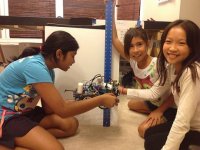Girls and Robotics
Your content has been saved!
Go to My Saved Content.Editor's Note: In this blog sponsored by Lego, author Mary Beth Hertz mentions her use of the Lego Mindstorm product. Hertz did not know Lego was sponsoring her blog and Lego made no request for product mentions. To best serve our audience, Edutopia is leaving the reference intact, as it reflects the facts of the author's experience and not any commercial arrangement between Lego and Edutopia.
Right now in education, it seems like everyone is talking about STEM (Science, Technology, Engineering and Math). Once again, our government has had a knee-jerk reaction to the success that other countries are having on international science and math tests. For many robotics coaches, this is all a bit "ho-hum." For decades, teams of students have been applying their knowledge of math, physics, electronics and computers to build machines that complete specific tasks and challenges. These teams have been working hand in hand with professional engineers as well as their teacher-coach, and they have been turning these experiences into internships at big-name companies and eventually into full-time careers.
I attended a FIRST Robotics League competition here in Philadelphia last year to see the teams compete and get a backstage look at the world of robotics. My friend Dave Zirkle and his team were participating in the competition. I stood by watching the team make some final tests and discussing strategy while they waited their turn to compete. There was one glaring element lacking at what was an action-packed and fascinating afternoon: girls. Aside from the one all-girl robotics team I saw, very few girls were present.
A Robotics Club is Born
A couple of years ago, I was lucky enough to teach a summer course on robotics using LEGO Mindstorms robotics kits. I had never taught robotics before, and for the most part I was learning with the kids, but I fell in love with this particular STEM practice. The hands-on experience of building, the time put into troubleshooting a program, the excitement when the robot you built completes a challenge -- it was hours of fun. When I returned to my school in the fall, I knew I wanted to run a robotics club. I knew I wanted it to be only for girls. I knew it would cost a lot of money. However, after some fundraising, I was able to purchase two LEGO Mindstorms starter kits. I had four girls building, testing, troubleshooting and programming. Sometimes we had to review math concepts when deciding how many rotations our robot's wheels needed to make. Sometimes we needed to explore value ranges for our sensors and actually apply the concepts of greater than and less than, seeing our results in the actions our robot took (or didn't).
I took some of my girls to the robot expo so they could see the next level of robotics, should they want to continue in high school. They had a blast.
One interesting fact I learned from talking to students at the competition is that robotics team members have lots of different roles. Just like any team, each person brings a different expertise to the table. Some of the girls were builders and programmers, but some did more work in marketing and planning the team's fundraising strategy or in project management. These teams are part of a national competition, and there are strict deadlines.
What I found to be the most amazing about the conversations I had with students was that many of them were already working at engineering firms and companies (usually the one that sponsored their team) or, if they were high school seniors, the company was helping pay some of their college tuition with the promise of a job when they graduated.
Crossing the Gender Barrier
With such a small population of girls present at the competition, I wonder how many young ladies are missing out on these opportunities? We need to make robotics and other viable career pathways appealing to young women and girls. One way is by exposing girls to more opportunities for building, making and doing in the classroom. This kind of stuff is not just for boys! Girls enjoy soldering just as much as boys do. We can also show girls who are not really into the "techie" side of things that a career in a technology-related field can translate into project-management, branding and marketing.
What better way to engage girls in both sides of the tech world and provide pathways to successful careers than through robotics?
